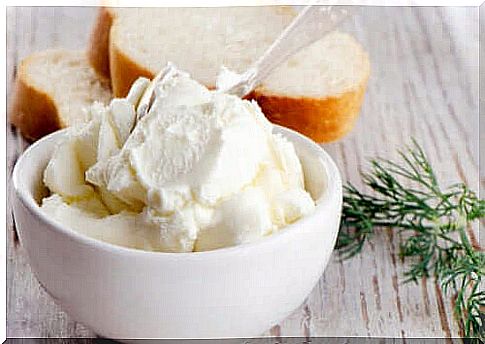Is Cream Cheese Good For Your Diet?

According to the Codex Alimentarius , cream cheese is a soft, spreadable, unripened and rindless cheese. The texture is spreadable and smooth to slightly crumbly and without holes.
The cheese therefore spreads and mixes easily with other foods. However, it is not part of most healthy diets due to its high fat content. But, is cream cheese good for you?
The fat in milk can provide some understated benefits, which we’ll talk about later. Cream cheese and its various types, such as whipped cream and flavored types, among others, are also used to add a unique flavor to many sweet and savory preparations.
Many people consume it for its taste, versatility and texture. But do you know what each serving contains? Do you know how it is made? Keep reading this article to discover the answers to these and other questions.
How cream cheese is made
As published in the Journal of Dairy Science , the raw material for making this food is heavy cream or a mixture of cream and milk. The cream is pasteurized and transformed into very small fat droplets. Then lactic acid bacteria are added. Manufacturers then ferment the cheese and make it more acidic.
Then they add salt and certain additives such as gelatin, starch and other thickeners and emulsifiers recommended by the Codex Alimentarius (Spanish link).
Finally, they add a coagulant. Foods magazine states that this is an enzyme of plant or animal origin that breaks down milk proteins to make it clot.
Once it’s firm, manufacturers mix everything before packing the cheese hot or cold. According to the Codex Alimentarius , it contains 25 grams of milk fat per 100 grams in dry matter and 67% water. Other fat values vary depending on the preparation.
Is Cream Cheese Nutritious?
According to the FoodData Central of the United States Department of Agriculture (English link) and the PAHO/WHO (Spanish link), 100 grams of cream cheese contains the following macro and micronutrients:
- Water: 54%
- Fats: 32%
- Saturated fat: 21.43%
- Protein: 7.1%
- Carbohydrates: 7.14%
- Calories: 321
- Vitamin A: 300 micrograms of retinol
- Riboflavin: 0.20 mg
- Calcium: 71mg
- Phosphorus: 104mg
This dairy product therefore contains a lot of fat, of which about 67% is saturated. It contains less protein, calcium and phosphorus than other cheeses. It is rich in vitamin A.
Light cream cheese (English link) contains 67% water, 7.8% protein, 8% carbohydrates and 15% fat. With 160 micrograms, it contains less vitamin A values than traditional cream cheese.
It also contains 9% saturated fat and 148 mg of calcium. Cream cheese contains 40% fewer calories than regular cheese.

Fatty acids
A large part of the fatty acids in whipped cream is very small, which promotes absorption in the intestines. Professor Gaspar Ros notes that they can be used as fast energy sources.
One of these is butyric acid, which according to the journal Hospital Nutrition benefits colon cells and improves gut health.
Types of proteins
Whipped cream contains casein and whey protein. A group of experts (Spanish link) agreed that these are of high biological value because they contain many essential amino acids, such as lysine. However, the protein content is not enough to be recommended in high-protein diets.
Carbohydrates
The lactic acid bacteria added during production break down most of the carbohydrates in this product. According to the journal Agricultural Matters , these microorganisms convert lactose into lactic acid, which conditions the gut to prevent the growth of disease-causing bacteria.
Vitamins
The main vitamin in cream cheese is vitamin A. This vitamin is important for visual development, bone growth and the immune system.
One serving provides 84 micrograms of retinol, which represents 10% of the recommended value, according to ALAN magazine.
Minerals
As with other cheeses, calcium and phosphorus are the most abundant minerals. However, they are found in fewer amounts, as they contain less protein. A serving of 30 grams per day barely covers 2% of the recommended calcium intake.
Calories
Traditional cream cheese is high in calories. Spreading 28 grams on a sandwich or biscuit corresponds to an intake of 90 calories. So you have to be careful about the energy intake of this product when you include it in your diet.
How can you use cream cheese in the kitchen?
The texture and taste of cream cheese are the greatest culinary assets of this delicious dairy product. You can make both sweet and savory dishes with it.
The most common way to use it is to spread it on biscuits, toast and muffins, as an ingredient in fillings, for baked potatoes or in sandwiches.
You can also make delicious creamy dressings and serve them with pasta, fish, chicken or vegetables. If you combine it with spices, the taste will be explosive.
If you are going to bake, it is perfect for fillings and toppings, such as carrot cake. Ice creams also use cream cheese as a base in combination with various fruits. Brownies and cheesecakes also taste great when prepared with this product.
As Brighenti and other researchers point out, the properties of cream cheese make it an ideal product for improving the texture of a dish. For example, adding two tablespoons to puff pastry and focaccia makes them softer and richer.
These foods allow you to challenge yourself in the kitchen. For example, a fruit or vegetable smoothie with cream cheese makes it creamier. Let your imagination run wild!
The benefits of cream cheese
In addition to its nutritional value, this product has some benefits that we will discuss below.
It could be a possible probiotic
According to the World Gastroenterology Organization (WHO – Spanish link), probiotics are microorganisms that can improve gut health and boost immune function.
According to the Journal of Biological and Health Sciences , this cheese is fermented with certain Lactobacillus that may have a probiotic function and are considered safe. Some studies (Spanish link) show the results of using Lactobacillus casei as a probiotic in this product to make it of optimal quality.
It contains little lactose
Many people cannot tolerate lactose in milk because they lack the enzyme that breaks it down in the gut. This causes bloating, gas and diarrhea. Nevertheless, the journal Nutrients clarifies that some intolerant people can only tolerate 12 grams of lactose per day.
28 grams of cream cheese contains a maximum of 2 grams of lactose. As long as those who suffer from lactose intolerance consume it in moderation, it shouldn’t cause any problems. However, there are as yet no studies on the effect in these types of patients.
Cream cheese is rich in antioxidants
Astiasrán and Martínez (Spanish link) stated in their book that the fat in milk contains carotenoids, such as beta-carotenes, lutein and zeaxanthin. Young and Loug (link in English) discuss antioxidant activity, as they block the action of free radicals and their possible cell damage. Some carotenes have a direct effect on eye health.

Contraindications of cream cheese
Does this food also have contraindications? Yes, including the ones below.
It is a low-protein dairy product
A normal serving of this cheese contains only two grams of protein. Thus, unlike other cheeses, such as goat cheese or cheddar, which have seven grams per serving, it is not recommended for high-protein diets.
Consumption of saturated fat
Cream cheese is high in saturated fat. A 28 gram serving covers 30% of the daily recommended value on a 2,000 calorie diet.
The World Zoning Organization (WHO – Spanish link) recommends reducing saturated fats to less than 10% of total energy intake to help prevent chronic disease.
Cream cheese is a high-calorie food
This food is high in calories, which means it is not included in weight loss diets. If you are on a diet, you should avoid dishes where cream cheese is the main ingredient. Experts recommend replacing it with light or low-fat cream cheese.
It has a very short shelf life
Despite the fact that cream cheese is pasteurized and destroys pathogenic microorganisms, Choi and other authors argue that its high water content can increase the risk of contamination and shorten its shelf life.
It has been proven to last for 2 weeks and should be kept refrigerated after opening
Is Cream Cheese Good For You?
The culinary properties and applications of this food that generates flavors in various preparations is beyond dispute. But is cream cheese nutritious?
When consumed in moderation, it is a good energy source with little lactose and a source of vitamin A. You can replace traditional cream cheese that is high in saturated fat and calories with other light versions to make it part of a healthy diet.
While adding probiotic bacteria could also make it more competitive in the health-promoting dairy market, experts need to do more research in this regard.









